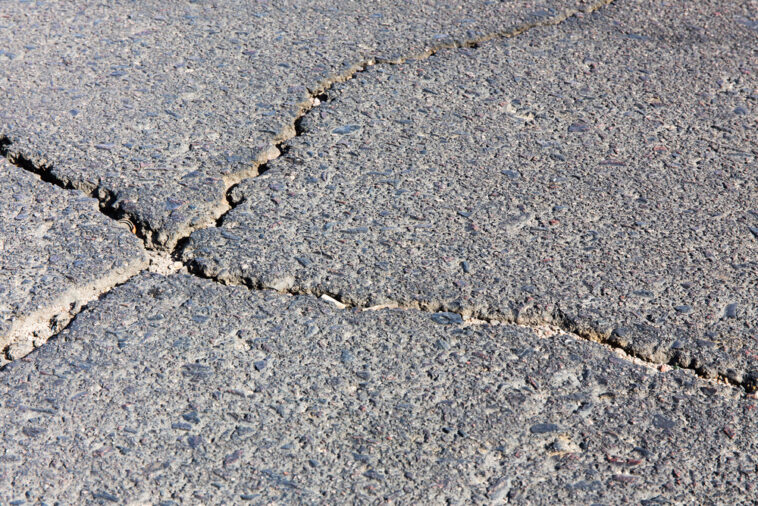In our bustling world, where the rhythm of daily life flows along the concrete veins of road networks, the condition of our roadways often fades into the background of our consciousness. Yet, two persistent and seemingly innocuous challenges, cracked asphalt and missing traffic signs punctuate our journeys, reminding us of their undeniable impact.
Our roadways, whether expansive highways or quiet neighborhood streets form the lifelines of our communities, vital for commerce, connectivity, and daily mobility. Ensuring their resilience is paramount, yet the presence of road defects mar our travels and imperils our well-being.
The Dangers of Cracked Asphalt
- Increased Risk of Accidents: Cracked asphalt reduces traction and control, increasing the likelihood of accidents, particularly in adverse weather.
- Vehicle Damage: Potholes and uneven surfaces caused by cracked asphalt can damage vehicles, leading to costly repairs and safety hazards.
- Environmental Consequences: Neglected asphalt contributes to environmental issues, including increased fuel consumption due to rough road surfaces and the release of harmful chemicals.
- Economic Costs: Repairing cracked asphalt entails significant costs, not only for road repairs but also for the collateral damage caused to vehicles.
The dangers of defective roads underscore the importance of proactive maintenance and repairs to ensure safer and more reliable roadways for all.
The Significance of Missing Traffic Signs

Amid the sprawling network of roads and highways, traffic signs often blend into the urban landscape, their importance easily overlooked. However, the absence or deterioration of these crucial elements can lead to significant challenges and safety risks.
Traffic signs serve as silent guardians, providing essential information, warnings, and regulations to drivers. They guide us through complex intersections, notify us of speed limits, and caution us about hazards ahead.
When a critical sign is missing or damaged, confusion ensues among motorists. This confusion can result in traffic violations, such as running red lights or failing to yield, putting everyone on the road at risk.
Identifying the Causes
Understanding the root causes of cracked asphalt and the absence of traffic signs is essential for developing effective solutions and implementing preventive measures. These issues, though seemingly minor, can have profound implications for road safety and infrastructure reliability.
- Cracked Asphalt: Cracked asphalt results from a combination of factors, including environmental forces and human actions.
- Weather Conditions: Extreme weather fluctuations, including freezing temperatures, heavy rainfall, and scorching heat, take a toll on asphalt surfaces over time. These conditions cause the asphalt to expand and contract, leading to the development of cracks.
- Poor Construction and Maintenance Practices: Inadequate construction methods and insufficient maintenance exacerbate the problem. These issues may include improper compaction during road construction, the use of subpar materials, and delayed or irregular maintenance schedules.
- Missing Traffic Signs: The absence of essential traffic signs can be attributed to both deliberate actions and natural wear and tear.
- Vandalism: Deliberate acts of vandalism, sadly, play a role in removing or damaging traffic signs. Such acts disrupt the flow of traffic, create hazards for drivers, and result in confusion at intersections.
- Aging Infrastructure: Over time, traffic signs naturally degrade due to wear and tear. The reflective coatings wear out, sign posts deteriorate, and visibility diminishes, necessitating regular replacement and maintenance.
- Government and Municipal Responsibilities: Governments and municipal authorities play a critical role in overseeing road maintenance and traffic signage. Ensuring adequate funding, implementing and enforcing regulations, and coordinating timely maintenance efforts are essential responsibilities in addressing these challenges.
The Solutions

Addressing the challenges of cracked asphalt and missing traffic signs requires a multifaceted approach, involving preventive measures, timely interventions, and innovative solutions to maintain road safety and infrastructure integrity.
Implementing routine inspections and proactive maintenance schedules can identify and address cracks before they worsen, preventing accidents and costly repairs. Utilizing resurfacing techniques and rehabilitation projects can revitalize deteriorating road surfaces, extending their lifespan and improving safety.
Engaging communities in reporting and monitoring road conditions fosters a sense of shared responsibility and accelerates problem-solving.
Establishing efficient protocols for the swift replacement or repair of damaged or missing traffic signs is vital to maintaining traffic order and safety. Explore emerging technologies like smart traffic signs, which can provide real-time information and updates to drivers, reducing dependence on traditional signs.
Emphasize the importance of collaboration between government agencies and local communities in addressing these challenges effectively, ensuring that road maintenance and traffic signage are collective responsibilities.
The Role of Technology
In an age of rapid technological advancement, innovative solutions have emerged to confront the persistent issues of these road defects. Technology stands as a pivotal ally in enhancing both road maintenance and traffic signage systems, presenting opportunities for heightened efficiency and safety.
Within the realm of road maintenance, cutting-edge advancements have revolutionized how we detect and address issues. Pothole detection systems, for instance, employ sensors and data analytics to identify road surface irregularities swiftly, reducing response times and improving the overall quality of roadways.
In the domain of traffic signage, the emergence of smart traffic signs signifies a significant leap forward. These signs are equipped with sensors, cameras, and communication capabilities that provide real-time information to drivers.
This real-time data can include traffic conditions, weather alerts, and lane closures, empowering drivers to make informed decisions and adapt to changing circumstances swiftly. The benefits are manifold, encompassing improved traffic flow, enhanced road safety, and a decreased reliance on traditional signage.
However, the adoption of these advanced technologies is not without its challenges, factors like cost, infrastructure requirements, and public acceptance pose significant hurdles. The successful integration of these innovations necessitates careful planning and investment.

Conclusion
In the journey through the challenges of cracked asphalt and missing traffic signs, we have unearthed the hidden perils that endanger our safety and daily routines. These seemingly minor roadblocks have far-reaching consequences, from accidents and vehicle damage to environmental degradation and confusion on the roads.
However, the path to safer and smoother journeys lies in our collective hands. By recognizing the dangers, identifying root causes, and embracing innovative solutions and technology, we can pave the way toward well-maintained roads and functional signage.
It is a call to action, a reminder that the preservation of our roads is a shared responsibility, ensuring that our highways and byways remain the lifelines of our communities.




